deviled eggs; bacon-cheese sandwich filling
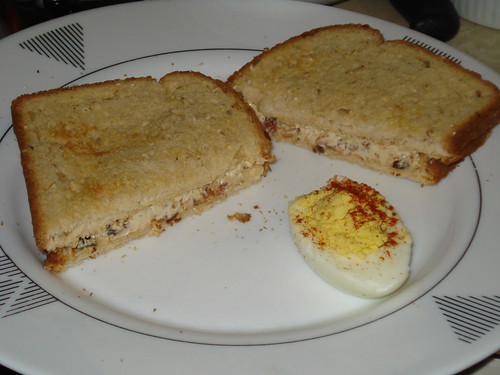 Health-For-Victory Club Meal Planning Guide is a 1943 pamphlet from the Home Economics Institute of Westinghouse in Mansfield, Ohio. So it brings together wartime scarcity and rationing with the precepts of early-20th-century home economics, which means a lot of things with white sauce.
Health-For-Victory Club Meal Planning Guide is a 1943 pamphlet from the Home Economics Institute of Westinghouse in Mansfield, Ohio. So it brings together wartime scarcity and rationing with the precepts of early-20th-century home economics, which means a lot of things with white sauce.
In all fairness, the majority of the recipes are reasonably wholesome, and cover a wide variety of dishes. The quick bread section includes blueberry nut bread, French toast, corn bread and griddle cakes. Cakes and cookies include gingerbread, oatmeal cookies and lemon molasses cupcakes. There are rarebits, chicken fricassee, cherry dumplings, peach shortcake, and chicken and noodles, as well as the intriguingly named “macaroni hoe.” (It appears to be a 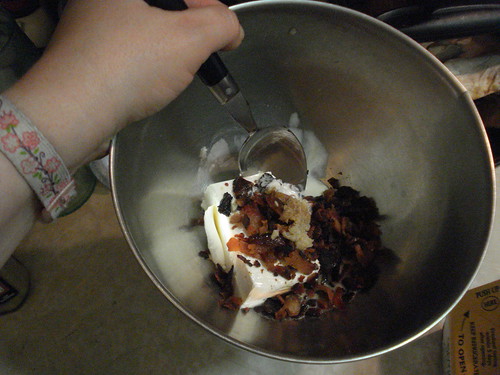 robust mac and cheese souffle with an egg base, flavored with green pepper and pimiento.) There’s also a section on dehydrating and brining food to preserve your garden’s output, and tips on making the most of your ration points. And there’s a lot of very sound nutritional advice (such as saving the cooking water from vegetables to use in soups, or relying on beans and nuts for your protein when meat is scarce).
robust mac and cheese souffle with an egg base, flavored with green pepper and pimiento.) There’s also a section on dehydrating and brining food to preserve your garden’s output, and tips on making the most of your ration points. And there’s a lot of very sound nutritional advice (such as saving the cooking water from vegetables to use in soups, or relying on beans and nuts for your protein when meat is scarce).
I don’t know if I’m just unusually sensitive to summer heat (this is very possible) or if cultural standards have changed, but the June 1943 book seems to have a lot of heavy, hot and starchy foods for the season. Fruits are stewed; hot cereals are offered; macaroni stars in a lot of non-salad dishes. I didn’t realize this when I was scheduling the various cookbooks, so had to dig a bit to find something suitable for the August heat. But I came up with two recipes that worked well for a cold supper on a warm night: deviled eggs, and bacon-and-cream-cheese sandwich filling.
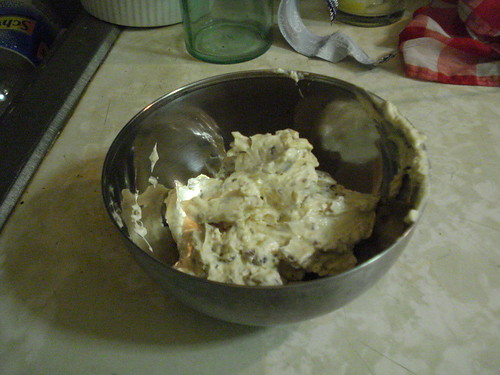 The sandwich filling was pretty easy. I cooked yet more bacon (at this rate I need to buy stock in Ajax Dishwashing Liquid) and chopped up enough for 1/4 cup; I mixed this with 3 ounces of cream cheese, plus a bit of horseradish, Worcestershire sauce and milk, then chilled it until it was time to spread it on toasted bread. It tasted good. (Is that surprising when the major flavor element is bacon?) The recipe produced enough for three moderate sandwiches or possibly two generous ones, but we went with moderate.
The sandwich filling was pretty easy. I cooked yet more bacon (at this rate I need to buy stock in Ajax Dishwashing Liquid) and chopped up enough for 1/4 cup; I mixed this with 3 ounces of cream cheese, plus a bit of horseradish, Worcestershire sauce and milk, then chilled it until it was time to spread it on toasted bread. It tasted good. (Is that surprising when the major flavor element is bacon?) The recipe produced enough for three moderate sandwiches or possibly two generous ones, but we went with moderate.
The deviled eggs were a bit more work. I followed the booklet’s instructions for hard-cooking the eggs: put the eggs in a pan and cover with cold water, bring to a boil, and simmer 5-8 minutes, then drain off the hot water and rinse well with cold to stop the cooking. At this point the 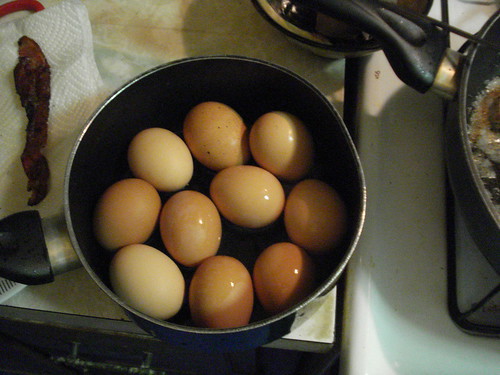 smart thing to do would have been to immediately peel the eggs under cold running water, but I was cooking them a day ahead and so put them into the fridge in the shells. This meant that despite the fairly generous air pocket at the end of some of them (a sign that the eggs were not perfectly fresh, though they were still quite good), the shells did not come off too easily when I did peel them. I didn’t utterly mutilate them, though.
smart thing to do would have been to immediately peel the eggs under cold running water, but I was cooking them a day ahead and so put them into the fridge in the shells. This meant that despite the fairly generous air pocket at the end of some of them (a sign that the eggs were not perfectly fresh, though they were still quite good), the shells did not come off too easily when I did peel them. I didn’t utterly mutilate them, though.
Once the eggs are peeled, they should be cut in half lengthwise, and the yolks pressed through a sieve into a bowl. I used a finer sieve than I think was intended, so it took a bit of time and didn’t do much good for the sieve, but it did make for a nice fluffy filling and no big chunks of yolk. Mix the sieved yolks with some cream, vinegar, mustard, Worcestershire sauce, salt and pepper, and beat the mixture until fluffy. Or, in my case, until you get impatient to 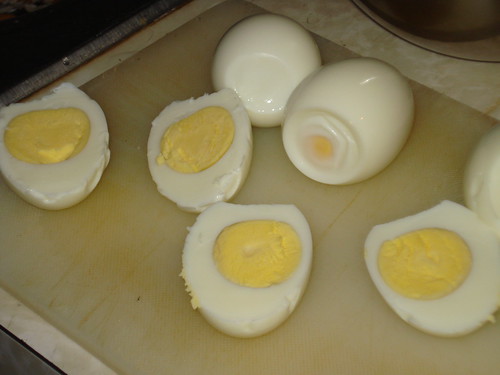 get on with it. Scoop the yolk mixture back into the egg halves. You could use a pastry bag to make it pretty, but I didn’t bother. Garnish with paprika or chives.
get on with it. Scoop the yolk mixture back into the egg halves. You could use a pastry bag to make it pretty, but I didn’t bother. Garnish with paprika or chives.
The deviled eggs tasted good. I wouldn’t say great, but then I’m not really an aficionado, so it’s an uncommon deviled egg indeed that will have me singing its praises. I was perfectly happy with them. I served up the sandwiches and eggs with a sizable green salad, on principle.
Verdict: Success. The recipes were not complicated, and the instructions were clear and accurate. The results tasted good. The bacon-cream-cheese filling certainly does a good job of stretching the serving of bacon; even a generously spread sandwich uses less than half the bacon you’d put 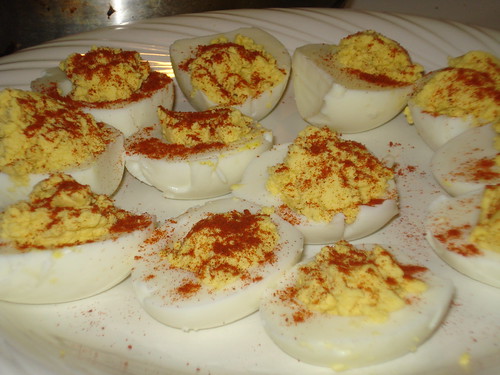 on a single BLT. And the hard-boiled egg instructions were right on target, producing nicely yellow yolks (two were slightly tinged with green — I think those eggs were older — but not enough to affect the color of the filling). I don’t feel especially called to make either again, but I don’t specifically object to doing so.
on a single BLT. And the hard-boiled egg instructions were right on target, producing nicely yellow yolks (two were slightly tinged with green — I think those eggs were older — but not enough to affect the color of the filling). I don’t feel especially called to make either again, but I don’t specifically object to doing so.
Gawd, how I LOOOOOVE deviled eggs. If Dave makes a dozen eggs’ worth, I can EASILY eat half. Which is just horrible for me, but they’re so gooood, I just can’t help myself.